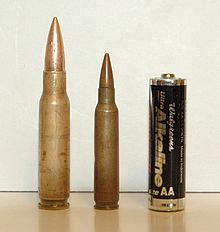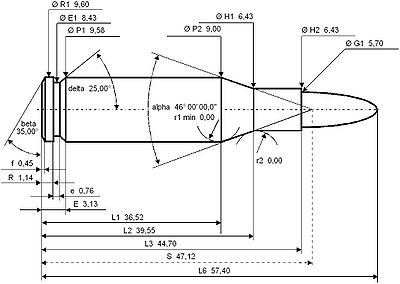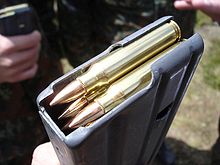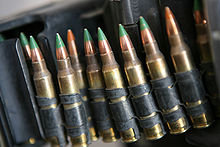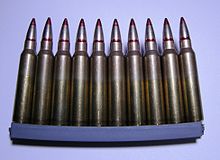- 5.56×45mm NATO
-
5.56×45mm NATO 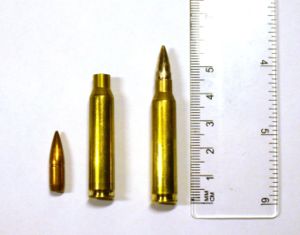
5.56x45mm NATO with measurementType Rifle Place of origin  United States of America
United States of AmericaService history In service 1963–Present Used by NATO Wars Vietnam War–present Production history Designer Remington Arms Specifications Parent case .223 Remington Case type Rimless, bottleneck Bullet diameter 5.70 mm (0.224 in) Neck diameter 6.43 mm (0.253 in) Shoulder diameter 9.00 mm (0.354 in) Base diameter 9.58 mm (0.377 in) Rim diameter 9.60 mm (0.378 in) Rim thickness 1.14 mm (0.045 in) Case length 44.70 mm (1.760 in) Overall length 57.40 mm (2.260 in) Case capacity 1.85 cm³ (29 gr H2O) Rifling twist 178 mm or 229 mm (1 in 7 in or 9 in, originally 1 in 14 in) Primer type Small rifle Maximum pressure 430.00 MPa (62,366 psi) Ballistic performance Bullet weight/type Velocity Energy 4 g (62 gr) SS109 FMJBT 940 m/s (3,100 ft/s) 1,767 J (1,303 ft·lbf) 4.1 g (63 gr) DM11 FMJBT 936 m/s (3,070 ft/s) 1,796 J (1,325 ft·lbf) 4.1 g (63 gr) GP 90 FMJBT 905 m/s (2,970 ft/s) 1,679 J (1,238 ft·lbf) Test barrel length: 508 mm (20.0 in)
Source(s): NATO EPVAT testing, QuickLOAD, SAAMI, C.I.P.[1]5.56×45mm NATO (official NATO nomenclature 5.56 NATO) is a rifle cartridge developed in the United States and originally chambered in the M16 rifle. Under STANAG 4172, it is a standard cartridge for NATO forces as well as many non-NATO countries. It is derived from, but not identical to, the .223 Remington cartridge. When the bullet impacts at high velocity and yaws in tissue, fragmentation creates a rapid transfer of energy which can result in dramatic wounding effects.[2][3][4]
Contents
History
The 7.62×51mm NATO and 5.56×45mm NATO cartridges compared to an AA battery.
The previous standard NATO rifle cartridge was the 7.62×51mm NATO, derived from the .308 Winchester rifle cartridge and designed to replace the U.S. military's .30-06 Springfield rifle cartridge. At the time of selection, there had been criticism that the 7.62 mm was too powerful for modern service rifles, causing excessive recoil, and that the weight of the ammunition did not allow for enough rate of fire in modern combat.
The British had extensive evidence with their own experiments into an intermediate cartridge since 1945 and were on the point of introducing a .280 inch (7 mm) cartridge when the selection of the 7.62 mm NATO was made. The FN company had also been involved. The concerns about recoil and effectiveness were effectively overruled by the US within NATO, and the other NATO nations accepted that standardization was more important at the time than selection of the ideal cartridge. However the concerns would prove to be valid and led to the development of the 5.56 cartridge.
During the late 1950s, ArmaLite and other U.S. firearm designers started their individual Small Caliber/High Velocity (SCHV) assault rifle experiments using the commercial .222 Remington cartridge. When it became clear that there was not enough powder capacity to meet U.S. Continental Army Command's (CONARC) velocity and penetration requirements, ArmaLite contacted Remington to create a similar cartridge with a longer case body and shorter neck. This became the .222 Remington Special. At the same time, Springfield Armory's Earle Harvey had Remington create an even longer cartridge case then known as the .224 Springfield. Springfield was forced to drop out of the CONARC competition, and thus the .224 Springfield was later released as a commercial sporting cartridge known as the .222 Remington Magnum. To prevent confusion with all of the competing .222 cartridge designations, the .222 Remington Special was renamed the .223 Remington. After playing with their own proprietary cartridge case design, the .224E1 Winchester, Winchester eventually standardized their case dimensions, but not overall loaded length, with the .222 Remington Special to create a cartridge known as the .224E2 Winchester. With the U.S. military adoption of the ArmaLite AR-15 as the M16 rifle in 1963, the .223 Remington was standardized as the 5.56×45mm. However, the .223 Remington was not introduced as a commercial sporting cartridge until 1964.
In a series of mock-combat situations testing in the early 1960s with the AR-15, M14 and AK-47, the Army found that the AR-15's small size and light weight allowed it to be brought to bear much more quickly. Their final conclusion was that an 8-man team equipped with the AR-15 would have the same firepower as a current 11-man team armed with the M14. U.S. troops were able to carry more than twice as much 5.56×45mm ammunition as 7.62×51mm for the same weight, which would allow them a better advantage against a typical NVA unit armed with AK-47s.
Rifle Cartridge Cartridge weight Weight of loaded magazine Max. 10 kilogram ammo load M14 7.62×51mm 393 gr 20 rd mag @ 0.68 kg 14 mags @ 9.52 kg for 280 rds M16 5.56×45mm 183 gr 20 rd mag @ 0.3 kg 33 mags @ 9.9 kg for 660 rds AK-47 7.62×39mm 281 gr 30 rd mag @ 0.92 kg*[5] 10 mags @ 9.2 kg for 300 rds (*AK-47 magazines are much heavier than M14 and M16 magazines)
During the 1970s, NATO members signed an agreement to select a second, smaller caliber cartridge to replace the 7.62 mm NATO cartridge. Of the cartridges tendered, the 5.56x45mm was successful, but not the 55 gr M193 round used by the U.S. at that time. The wounds produced by the M193 round were so devastating that many[6] consider it to be inhumane.[7][8] Instead, the Belgian 62 gr SS109 round was chosen for standardization. The SS109 used a heavier bullet with a steel core and had a lower muzzle velocity for better long-range performance, specifically to meet a requirement that the bullet be able to penetrate through one side of a steel helmet at 600 meters. This requirement made the SS109 (M855) round less capable of fragmentation than the M193 and was considered more humane[9]
Cartridge dimensions
The 5.56×45mm NATO has 1.85 ml (28.5 grains H2O) cartridge case capacity.
5.56×45mm NATO maximum NATO cartridge dimensions. All sizes in millimeters (mm).[10][11]
Americans would define the shoulder angle at alpha/2 = 23 degrees. The common rifling twist rate for this cartridge is 178 mm (1 in 7 in) or 229 mm (1 in 9 in), 6 grooves, Ø lands = 5.56 mm, Ø grooves = 5.69 mm, land width = 1.88 mm and the primer type is small rifle.
According to the official NATO proofing guidelines the 5.56×45mm NATO case can handle up to 430 MPa (62,000 psi) piezo service pressure. In NATO regulated organizations every rifle cartridge combo has to be proofed at 125% of this maximum pressure to certify for service issue. This is equal to the C.I.P. maximum pressure guideline for the .223 Remington cartridge, that is the 5.56×45mm NATO parent cartridge.
Performance
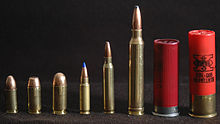 From left to right: 9×19mm Parabellum, .40 S&W, .45 ACP, 5.7×28mm, 5.56×45mm, .300 Winchester Magnum, and two shotgun shells; 2.75-inch (70 mm) and 3-inch (76 mm) 12 gauge.
From left to right: 9×19mm Parabellum, .40 S&W, .45 ACP, 5.7×28mm, 5.56×45mm, .300 Winchester Magnum, and two shotgun shells; 2.75-inch (70 mm) and 3-inch (76 mm) 12 gauge.
 Loading 5.56×45mm NATO cartridges into a STANAG magazine by stripper clip.
Loading 5.56×45mm NATO cartridges into a STANAG magazine by stripper clip.
The 5.56×45mm NATO cartridge with the standard military ball bullet (NATO: SS109; U.S.: M855) will penetrate approximately 15 to 20 in (38 to 51 cm) into soft tissue in ideal circumstances. As with all spitzer shaped projectiles it is prone to yaw in soft tissue. However, at impact velocities above roughly 2,500 ft/s (760 m/s), it may yaw and then fragment at the cannelure (the crimping groove around the cylinder of the bullet).[12] These fragments can disperse through flesh and bone, inflicting additional internal injuries.[13]
Fragmentation, if or when it occurs, imparts much greater damage to human tissue than bullet dimensions and velocities would suggest. This fragmentation effect is highly dependent on velocity, and therefore barrel length: short-barreled carbines generate less muzzle velocity and therefore lose wounding effectiveness at much shorter ranges than longer-barreled rifles. Proponents of the hydrostatic shock theory contend that the rapid transfer of energy also results in wounding effects beyond the tissue directly crushed and torn by the bullet and fragments.[2][3] These remote wounding effects are known as hydrostatic shock.[4]
Criticism
There has been much criticism of the poor performance of the bullet on target, especially the first-shot kill rate when the muzzle velocity of the used firearms and the downrange bullet deceleration do not achieve the minimally required terminal velocity at the target to cause fragmentation.[14] This wounding problem has been cited in incidents beginning in the first Gulf war, Somalia, and in the current conflicts in Iraq and Afghanistan. In recent lab testing of M855, it has been shown that the bullets do not fragment reliably or consistently from round-to-round, displaying widely variable performance. In several cases, yawing did not begin until 7–10 in of penetration. This was with all rounds coming from the same manufacturer.[14] This lack of wounding capacity typically becomes an increasingly significant issue as range increases (e.g., ranges over 50 m when using an M4 or 200 m when using an M16) or when penetrating heavy clothing, but this problem is compounded in shorter-barreled weapons. The 14.5 inches (37 cm) barrel of the U.S. military's M4 carbine generates considerably less initial velocity than the longer 20" barrel found on the M16, and terminal performance can be a particular problem with the M4.
Combat operations the past few months have again highlighted terminal performance deficiencies with 5.56×45mm 62 gr. M855 FMJ. These problems have primarily been manifested as inadequate incapacitation of enemy forces despite them being hit multiple times by M855 bullets. These failures appear to be associated with the bullets exiting the body of the enemy soldier without yawing or fragmenting.This failure to yaw and fragment can be caused by reduced impact velocities as when fired from short barrel weapons or when the range increases. It can also occur when the bullets pass through only minimal tissue, such as a limb or the chest of a thin, malnourished individual, as the bullet may exit the body before it has a chance to yaw and fragment. In addition, bullets of the SS109/M855 type are manufactured by many countries in numerous production plants.
Although all SS109/M855 types must be 62 gr. FMJ bullets constructed with a steel penetrator in the nose, the composition, thickness, and relative weights of the jackets, penetrators, and cores are quite variable, as are the types and position of the cannelures. Because of the significant differences in construction between bullets within the SS109/M855 category, terminal performance is quite variable—with differences noted in yaw, fragmentation, and penetration depths. Luke Haag's papers in the AFTE Journal (33(1):11–28, Winter 2001) also describes this problem.
—[14]However, if the bullet is moving too slowly to reliably fragment on impact, the wound size and potential to incapacitate a person is greatly reduced. Several alternate cartridges have been developed in an attempt to address the perceived shortcomings of 5.56 mm ammunition including the 6.5 mm Grendel and the 6.8 mm Remington SPC.
Recently, advances have been made in 5.56 mm ammunition. The US military has adopted for limited issue a 77-grain (5.0 g) "Match" bullet, type classified as the Mk 262. The heavy, lightly constructed bullet fragments more violently at short range and also has a longer fragmentation range.[15] Originally designed for use in the Mk 12 SPR, the ammunition has found favor with special forces[16] units who were seeking a more effective cartridge to fire from their M4A1 carbines. Commercially available loadings using these heavier (and longer) bullets can be prohibitively expensive and cost much more than military surplus ammunition. Additionally, these heavy-for-caliber loadings sacrifice even more penetrative ability than the M855 round (which has a steel penetrator tip). Performance of 5.56×45mm military ammunition can generally be categorized as almost entirely dependent upon velocity in order to wound effectively. Heavy OTM bullets enhance soft tissue wounding ability at the expense of hard-target/barrier penetration.
5.56 mm NATO versus .223 Remington
The 5.56 mm NATO and .223 Remington cartridges and chamberings are similar but not identical. It is a myth that military 5.56mmx45 cases are made thicker and commercial .223 cases and military 5.56mm cases generally have the same case capacity.[17] However, the NATO specification allows a higher chamber pressure. NATO EPVAT test barrels made for 5.56 mm NATO measure chamber pressure at the case mouth, as opposed to the location used by the United States civil standards organization SAAMI. The piezoelectric sensors or transducers NATO and SAAMI use to conduct the actual pressure measurements also differ. This difference in measurement method accounts for upwards of 20,000 psi (140 MPa) difference in pressure measurements. This means the NATO EPVAT maximum service pressure of 430 MPa (62,000 psi) for 5.56 mm NATO, is reduced by SAAMI to 55,000 psi (380 MPa) for .223 Remington.[18] In contrast to SAAMI, the other main civil standards organization C.I.P. defines the maximum service and proof test pressures of the .223 Remington cartridge equal to the 5.56 mm NATO.
The 5.56 mm NATO chambering, known as a NATO or mil-spec chamber, has a longer leade, which is the distance between the mouth of the cartridge and the point at which the rifling engages the bullet. The .223 Remington chambering, known as SAAMI chamber, is allowed to have a shorter leade, and is only required to be proof tested to the lower SAAMI chamber pressure. To address these issues, various proprietary chambers exist, such as the Wylde chamber (Rock River Arms)[19] or the ArmaLite chamber, which are designed to handle both 5.56 mm NATO and .223 Remington equally well. The dimensions and leade of the .223 Remington minimum C.I.P. chamber also differ from the 5.56 mm NATO chamber specification.
Using commercial .223 Remington cartridges in a 5.56 mm NATO chambered rifle should work reliably, but generally will not be as accurate as when fired from a .223 Remington chambered gun due to the longer leade.[20] Using 5.56 mm NATO mil-spec cartridges (such as the M855) in a .223 Remington chambered rifle can lead to excessive wear and stress on the rifle and even be unsafe, and SAAMI recommends against the practice.[21][22] Some commercial rifles marked as ".223 Remington" are in fact suited for 5.56 mm NATO, such as many commercial AR-15 variants and the Ruger Mini-14 (marked ".223 cal"), but the manufacturer should always be consulted to verify that this is acceptable before attempting it, and signs of excessive pressure (such as flattening or gas staining of the primers) should be looked for in the initial testing with 5.56 mm NATO ammunition.[23]
It should also be noted that the upper receiver (to which the barrel with its chamber are attached) and the lower receiver are entirely separate parts in AR-15 style rifles. If the lower receiver has either .223 or 5.56 stamped on it, it does not guarantee the upper assembly is rated for the same caliber, because the upper and the lower receiver in the same rifle can, and frequently do, come from different manufacturers – particularly with rifles sold to civilians or second-hand rifles.
In more practical terms, as of 2010 most AR-15 parts suppliers engineer their complete upper assemblies (not to be confused with stripped uppers where the barrel is not included) to support both calibers in order to protect their customers from injuries and to protect their businesses from litigation following the said injuries.
Comparison of 5.56mm NATO versus 7.62mm NATO
Cartridge Model Cartridge size Cartridge weight Bullet weight Velocity Energy 5.56mm NATO M855[24] 5.56×45mm 12.31 g (190 gr) 4.02 g (62 gr) 945.5 m/s (3,100 ft/s)[25] 1,797 J[26] 7.62mm NATO M80[27] 7.62×51mm 25.40 g (392 gr) 9.33 g (147 gr) 838.0 m/s (2,749 ft/s)[27] 3,275 J NATO Ball (U.S.: M855) can penetrate up to 3 mm (about 1⁄8 in) of steel at 600 meters.[28] According to Nammo, a Norwegian ammunition producer, the M995 can penetrate up to 12 mm (nearly 1⁄2 in) of RHA steel at 100 meters.[29]
There have been numerous attempts to create an intermediate cartridge that addresses the complaints of 5.56 NATO's lack of stopping power along with lack of controllability seen in rifles firing 7.62 NATO in full auto. Other cartridges focused on superior short-range performance by sacrificing long-distance performance due to relatively short engagement distances typically observed in modern warfare. As of late 2009, none of those cartridges gained any significant traction beyond special forces and sport shooting communities.
Examples include, but are not limited to: 6.8mm Remington SPC and 6.5mm Grendel.
Despite complaints that the 5.56 round lacks stopping power, others contend that animal studies of the wounding effects of the 5.56×45mm round versus the 7.62×39mm have found that the 5.56 mm round is more damaging, due to the post-impact behavior of the 5.56 mm projectile resulting in greater cavitation of soft tissues.[30] The US Army contended in 2003 that the lack of close range lethality of the 5.56×45mm was more a matter of perception than fact. With controlled pairs and good shot placement to the head and chest, the target was usually defeated without issue. The majority of failures were the result of hitting the target in non-vital areas such as extremities. However, a minority of failures occurred in spite of multiple hits to the chest.[31]
Military cartridge types
- Cartridge, Ball, F1 (Australia): 5.56×45mm FN SS109 equivalent produced by Australian Defence Industries(ADI), now Thales Australia.
- Cartridge, Blank, F3 (Australia): 5.56×45mm Blank cartridge produced by Australian Defence Industries(ADI), now Thales Australia.
- Cartridge, Ball, C77 (Canada): 5.56×45mm FN SS109 equivalent used in the C7, C8 and C9 type weapons.
- Cartridge, Blank, C79 (Canada): 5.56×45mm blank cartridge used in the C7, C8 and C9 type weapons.
- Cartridge, Ball, DM11 (Germany): 5.56×45mm 4.1 g dual core ball cartridge, green tip w/steel core, produced by RUAG Ammotec.
- Cartridge, Tracer, DM21 (Germany): 5.56×45mm tracer compliment to DM11, also produced by RUAG Ammotec.
- Cartridge, Ball, L2A1 (United Kingdom): 5.56×45mm FN SS109 equivalent produced by Radway Green.
- Cartridge, Tracer, L1A1 (United Kingdom): 5.56×45mm tracer compliment to L2A1, also produced by Radway Green.
- Cartridge, Caliber 5.56 mm, Ball, M193 (United States): 5.56×45mm 55-grain ball cartridge.
- Cartridge, Caliber 5.56 mm, Grenade, M195 (United States): 5.56×45mm grenade launching blank.
- Cartridge, Caliber 5.56 mm, Tracer, M196 (United States): 5.56×45mm 54-grain tracer cartridge, red cartridge tip.
- Cartridge, Caliber 5.56 mm, Dummy, M199 (United States): 5.56x45mm dummy cartridge, non firing, indented case.
- Cartridge, Caliber 5.56 mm, Blank, M200 (United States): 5.56×45mm violet-tipped blank cartridge.
- Cartridge, Caliber 5.56 mm, Ball, M202 (United States): 5.56×45mm 58-grain FN SSX822 cartridge
- Cartridge, Caliber 5.56 mm, Ball, XM287 (United States): 5.56×45mm 68-grain ball cartridge produced by Industries Valcartier, Inc. An Improved version was also produced designated XM779.
- Cartridge, Caliber 5.56 mm, Tracer, XM288 (United States): 5.56×45mm 68-grain tracer cartridge produced by Industries Valcartier, Inc. An Improved version was also produced designated XM780.
- Cartridge, Caliber 5.56 mm, Grenade, M755 (United States): 5.56×45mm grenade launching blank specifically for the M234 launcher.
- Cartridge, Caliber 5.56 mm, Ball, XM777 (United States): 5.56×45mm ball cartridge.
- Cartridge, Caliber 5.56 mm, Tracer, XM778 (United States): 5.56×45mm tracer cartridge.
- Cartridge, Caliber 5.56 mm, Ball, M855 (United States): 5.56×45mm 62-grain FN SS109 ball cartridge, green tip w/steel penetrator and a lead core.
- Cartridge, Caliber 5.56 mm, Ball, M855 Lead Free (United States):62-grain green tip w/tungsten penetrator and a steel core. Primarily used during training in countries with strict lead disposal laws.
- Cartridge, Caliber 5.56 mm, Ball, M855A1 (United States):62-grain green tip w/19-grain steel penetrator tip and a solid copper core.
- Cartridge, Caliber 5.56 mm, Tracer, M856 (United States): 5.56×45mm 64-grain FN L110 tracer cartridge
- Cartridge, Caliber 5.56 mm, Armor Piercing, M995 (United States): 5.56×45mm 52-grain AP cartridge, black cartridge tip.
- Cartridge, Caliber 5.56 mm, Tracer, XM996 (United States): 5.56×45mm so-called "Dim Tracer" with reduced effect primarily for use with night vision devices.
- Cartridge, Caliber 5.56 mm, Special Ball, Long Range, Mk 262 Mod 0/1 (United States): 5.56×45mm 77-grain Open-Tipped Match/Hollow-Point Boat-Tail cartridge. Mod 0 features Sierra Matchking bullet, while Mod 1 features either Nosler or Sierra bullet.
- Cartridge, Caliber 5.56 mm, MK318 MOD 0 enhanced 5.56 mm ammunition (United States): 5.56×45mm 62-grain Open-Tipped Match Boat-Tail cartridge.[32][33]
- Cartridge, 5.64 mm, Ball, MLU-26/P (United States): Early USAF designation for 5.56×45mm ball cartridge produced by Remington.
M855A1
June 2010, the United States Army announced it began shipping its new 5.56 mm cartridge, the M855A1 Enhanced Performance Round, to active combat zones. During testing, the M855A1 performed better than current 7.62×51mm NATO ball ammunition against certain types of targets (particularly hardened steel), blurring the performance differences that previously separated the two cartridges. The US Army Picatinny Arsenal stated that the new M855A1 offers improved hard target capability, more consistent performance at all distances, enhanced dependability, improved accuracy, reduced muzzle flash, and higher velocity compared to the M855 round. Further the Army stated the new M855A1 ammunition is tailored for use in M4 carbines but should also give enhanced performance in M16 rifles and M249 light machine guns. The new 62-grain (4 g) projectile or bullet used in the M855A1 round has a copper core with a 19-grain (1.2 g) steel "stacked-cone" penetrating tip. The M855A1 cartridge is sometimes referred to as "green ammo" because it fires a lead free projectile.[34][35][36][37][38][39]
The M855A1 was put on hold in August 2009 due to the experimental bismuth-tin alloy core exhibiting undependable ballistics at high temperatures. The US Army has since replaced the bismuth-tin alloy core with one of solid copper eliminating the heat issue. The United States Marine Corps purchased 1.8 million rounds in 2010, with plans to adopt the round to replace the interim MK318 SOST rounds used in Afghanistan when the M855A1 project was delayed.[40]
The all-copper M855A1 gives consistent performance against soft targets while the wounding effects of the old M855 depended on the yaw angle measured at the point of flesh impact.[41]
Mk 262
The Mk 262 is a match quality round manufactured by Black Hills Ammunition made originally for the Special Purpose Rifle (SPR). It uses a 77-grain (5.0 g) bullet that is more effective at longer ranges than the standard issue M855 round.
Two versions of the round have been procured to date. Initial production runs, designated Mark 262 Mod 0, lacked a cannelure. Subsequent production, designated Mk 262 Mod 1, added a cannelure to the bullet for effective crimping.
According to US DoD sources, the Mk 262 round is capable of making kills at 700 meters. Ballistics tests found that the round caused "consistent initial yaw in soft tissue" at more than 300 meters. Apparently it is superior to the standard M855 round when fired from an M4 or M16 rifle. It evidently possesses superior stopping power, and can allow for engagements to be extended to up to 700 meters. It appears that this round can drastically improve the performance of any AR15 platform weapon chambered to .223/5.56 mm. Superior accuracy, wounding capacity, stopping power and range power has made this the preferred round of many Special Forces operators, and highly desirable as a replacement for the older, Belgian-designed 5.56×45mm M855 NATO round.[42][43] Hard target penetration is slightly decreased.[44]
5.6mm Gw Pat 90
The 5.6mm Gw Pat 90 or GP 90 (5.6 mm Rifle Cartridge 90), is the standard round used by the Swiss military in its rifle, the SIG SG 550. The cartridge is also known as the Cart 5.6mm F to the French and Italian speaking Swiss militiamen. The Swiss refer to the round as the 5.6 mm Gw Pat 90, although it is interchangeable with the 5.56×45mm NATO and .223 Remington round. The Gw Pat 90 is optimized for use in 5.56 mm (.223 in) caliber barrels with a 254 mm (1:10 in) twist rate.
The Gw Pat 90 was designed for the SIG SG 550 when it came into production in 1987, replacing the SIG SG 510. Previous experience of a change in standard rifle had proved that changing the distance of fire for the training ranges was more expensive than the design of a new ammunition; this prompted the design of a cartridge nominally capable at 300 meters. The cartridge was also designed to reduce pollution by controlling lead emissions.[45] The bullet was originally clad with a nickel alloy jacket, however, this was found to cause excessive barrel wear, so in 1998 the nickel jackets were replaced with tombac jackets. In addition, in 1999 a copper plug was added to the base of the bullet to address environmental concerns.[45]
The ammunition is currently (2009) produced by RUAG Ammotec, a subsidiary of the RUAG group.[46] The ammunition is manufactured in three variations: the standard FMJ round, the tracer round, and a blank round.
The FMJ cartridge has a CuZn-alloy case and uses a double base propellant. The bullet is a 4.1 g (63 gr) tombac jacketed FMJ projectile with a G1 ballistic coefficient of 0.331 (ICAO) / 0.337 (Army Metro). The projectile contains approximately 95% Pb, 2% Sb, 3% Cu, and was designed for terminal ballistic instability. The required accuracy for Gw Pat 90 ammunition out of factory test barrels is 63 mm (0.72 MOA) for 10 rounds (100% radius measurement method) out to 300 m. The Gw Pat 90 cartridge dimensions are in accordance with the civilian C.I.P. standards for the .223 Remington C.I.P. chambering.[47]
The Gw Pat 90 is used both in the Swiss military and in sport shooting. The very high level of individual training in the Swiss militia (every single soldier bearing a weapon has to shoot for qualification once a year; see Gun politics in Switzerland) and the overall use of the Gw Pat 90 by the many Swiss citizens who shoot in competitions and for amusement has resulted in significant input on its usage. Over 1 billion cartridges have been produced as of 2005.
Use
Main article: List of 5.56x45mm NATO firearmsSee also
- 7.62×51mm NATO
- NATO EPVAT testing
- Table of pistol and rifle cartridges by year
- List of rifle cartridges
References
- ^ "C.I.P. decisions, texts and tables – free current C.I.P. CD-ROM version download (ZIP and RAR format)". http://www.cip-bp.org/index.php?id=tdcc-telechargement. Retrieved 2008-10-17.
- ^ a b Chamberlin FT, Gun Shot Wounds, in Handbook for Shooters and Reloaders, Vol. II, Ackley PO, ed., Plaza Publishing, Salt Lake City, Utah, 1966.
- ^ a b Sturtevant B, Shock Wave Effects in Biomechanics, Sadhana, 23: 579–596, 1998.
- ^ a b American Rifle: A Biography, Alexander Rose (2009) p. 375-376
- ^ Dockery, Kevin (2007). Future Weapons. p. 102.
- ^ International Legal Initiatives to Restrict Military Small Arms Ammunition W. Hays Parks∗ Copyright 2010 by W. Hays Parks International Committee of the Red Cross (ICRC) page 1–18" (Which list International Committee of the Red Cross, Austria, Argentina, Belgium, Bolivia, Bulgaria, Burundi, Cambodia, Cyprus, Germany, Ireland, Latvia, Lithuania, Luxembourg, Mauritius, Mexico, Romania, Samoa, Slovenia, Sweden, Switzerland, etc. as parties that consider the 55 gr M193 round to be inhumane)
- ^ Ian V. Hogg, Military Small Arms of the 20th Century, 1981
- ^ International Legal Initiatives to Restrict Military Small Arms Ammunition W. Hays Parks∗ Copyright 2010 by W. Hays Parks International Committee of the Red Cross (ICRC) page 1-18"
- ^ The Small Arms Review vol.10, no.2 November 2006.
- ^ NATO EPVAT testing
- ^ QuickLOAD
- ^ Wound Ballistics: Basics and Applications edited by Beat P. Kneubuehl. p. 128. (2011)
- ^ "Reading Gunshot Patterns". NIH.gov. National Institute of Health. http://www.nlm.nih.gov/visibleproofs/galleries/technologies/patterns_image_5.html. Retrieved 14 October 2010.
- ^ a b c Wounding Info
- ^ (The Small Arms Review vol.10, no.2 November 2006).}
- ^ Jane's international defense review: IDR., Volume 39, Issues 1–6. p. 86. (2006).
- ^ 6mmbr.com. "223 Rem + 223 AI Cartridge Guide". http://www.6mmbr.com/223rem.html.
- ^ "SAAMI Pressures". http://www.leverguns.com/articles/saami_pressures.htm. Retrieved 2007-09-25.
- ^ Rock River Arms
- ^ News and Press Releases: .223 Rem VS 5.56mm, winchester.com, 5/4/2001
- ^ "Unsafe Arms and Ammunition Combinations" at SAAMI web site
- ^ SAAMI on 5.56 v. .223 Remington. The Gun Zone. Retrieved on 2011-01-08.
- ^ TECHNICAL NOTE 45: 5.56 NATO vs SAAMI .223 REMINGTON CHAMBERS, armalite.com, December 4, 2002
- ^ 5.56mm (5.56 × 45 mm) Ammunition. Inetres.com (2005-05-03). Retrieved on 2011-01-08.
- ^ "[Army TM 9-1005-319-23&P]"
- ^ KE = 1/2mv2, where m is in kilograms and v is in metres per second.
- ^ a b 7.62mm (7.62 × 51 mm) Ammunition. Inetres.com. Retrieved on 2011-01-08.
- ^ Pd Igman D.D. Konjic Bosnia And Herzegovina : Ammunition. Igman.co.ba. Retrieved on 2011-01-08.
- ^ 5.56mm (.22 Cal), nammo.com
- ^ [1] Acta Chir Scand Suppl. 1982;508:211-21.
- ^ [2] PROJECT MANAGER SOLDIER WEAPONS SOLDIER WEAPONS ASSESSMENT TEAM REPORT 6-03
- ^ Corps to use more lethal ammo in Afghanistan at www.marinecorpstimes.com
- ^ U.S. Navy Small Arms Ammunition Advancements
- ^ Army begins shipping improved 5.56mm cartridge
- ^ Small Caliber Ammunition Enhancing Capabilities, 20 May 2010
- ^ Military.com: 'Green Ammo' Heads to Afghanistan
- ^ U.S. Army Issues New M855A1 Ammo to Troops in Afghanistan
- ^ "Green" bullets from Picatinny Arsenal in NJ to be used in Afghanistan
- ^ M855A1 Enhanced Performance Round (EPR)
- ^ Lamothe, Dan; Cox, Matthew (12 July 2010). "Corps takes a new look at green bullet". Marine Corps Times. http://www.marinecorpstimes.com/news/2010/07/marine_ammo_071110w/. Retrieved 12 July 2010.
- ^ Lopez, Todd. "'Green bullet' as effective as M855 round - consistently." US Army News Service, 8 May 2011.
- ^ http://archives.gunsandammo.com/content/evolution-ar
- ^ AA53, Cartridge, Caliber 5.56mm Special Ball, Long Range Mk 262 Mod 0. Globalsecurity.org. Retrieved on 2011-01-08.
- ^ D. Robert Clements (September-October 2008), "The designated marksman equation", Infantry Magazine, http://findarticles.com/p/articles/mi_m0IAV/is_5_97/ai_n31140183/
- ^ a b Swiss Ammunition Enterprise
- ^ About The Swiss Ammunition Enterprise Corp. (SM)
- ^ RUAG Ammotec Sintox SWISS ORDNANCE cartridge fact sheet
Further reading
- Anthony G. Williams, Assault Rifles and Their Ammunition: History and Prospects, Online Article, October 21, 2006
- Stan Christ, "5.56mm NATO Alternatives", Special Weapons Magazine, Semi-Annual #50 2007, p. 52–59.
External links
- Various photos of 5.56×45mm ammunition
- RUAG Ammotech factsheet on German Army DM11 5.56×45mm ammunition
- RUAG Ammotech factsheet on German Army DM21 5.56×45mm ammunition
- ADI brochure on 5.56mm F1 ball ammunition conforming to the design parameters of the NATO STANAG 4172 and tested with Kistler 6215 transducers at different temperatures
- The AR15.COM Ammo-Oracle
- FAS: 5.56mm Ammunition
- The Gun Zone: 5.56mm FAQ
- The Gun Zone: A 5.56mm Timeline
- I.M.I Small Arms Ammunition Division
- Small Arms
- www.swissmun.ch
- www.swissrifles.com – The New GP 90
- RUAG Ammotec Defence Forces and Government Agencies Ammunitionpage
- RUAG Ammotec Sintox SWISS ORDNANCE cartridge fact sheet
- Swiss Ammunition Enterprise
Categories:- Pistol and rifle cartridges
- Military cartridges
Wikimedia Foundation. 2010.

